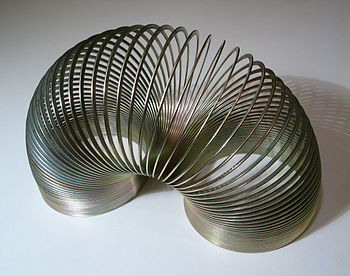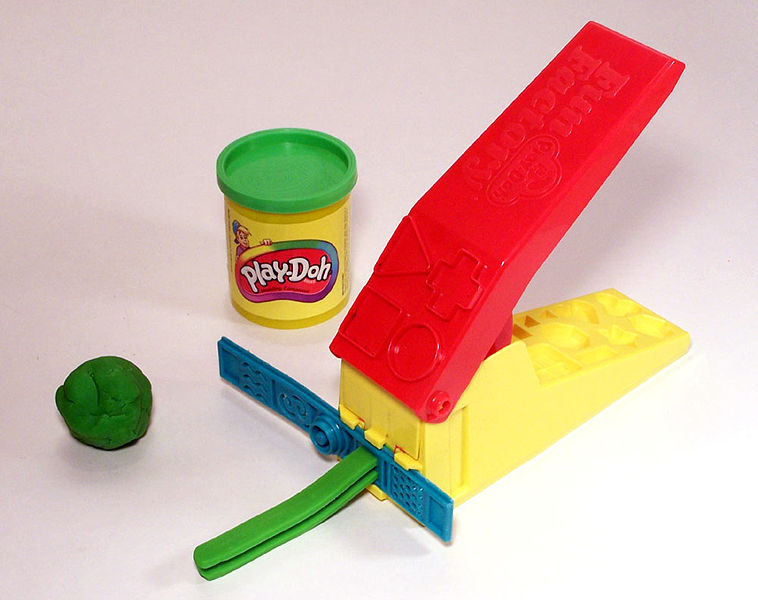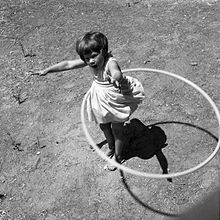Mid-Century Toys for Modern Girls and Boys, Part I
Kids and mid-century modern tract houses just go together. Joe Eichler and his contemporaries developed dwellings for young families, with kids in mind, and as David Weinstein explored in the Fall 2013 issue of CA-Modern, they did a good job. Kids still love living in mid-century modern homes, and parents love parenting in them. But the unique homes are not the only kid-friendly developments that have held up since the 50s and 60s. This week and next, we take a look at some of the toys that made their debut around the time Eichler was building his subdivisions, and that remain as popular today as they ever were.
 |
|
|
Slinky: A combination of creativity and clumsiness led to Slinky's creation in 1943, when mechanical engineer Richard James, who was working on developing springs to hold instruments in place on WWII battleships, knocked one of his prototypes off a shelf. When James saw the spring slide off the shelf instead of simply toppling, he thought kids could have some fun with it, and according to The Atlantic he spent the next two years experimenting with lengths and metallurgic formulas until he hit on the one we still know today. When he and his wife debuted the toy in a 1945 holiday demonstration at Gimbel's Department Store, in Philadelphia, they sold all 400 they had brought in an hour and a half.
 |
|
|
Silly Putty: A General Electric scientist named James Wright gets the credit for inventing the sometimes-liquid, sometimes-solid substance by accident in 1943 while trying to develop synthetic rubber. According to MIT, an out-of-work ad man named Peter Hodgson saw the goo at a party and realized he could sell it as a toy. With $147 in borrowed money, he bought the marketing rights to the substance from GE and started producing it as a toy in 1949. After appearing on the Howdy Doody show in 1957, the toy's popularity took off, and by 1961 it was being sold worldwide, as it still is today.
 |
|
|
Mr. Potato Head: Brooklyn native George Lerner, a toy inventor by trade, first started making face parts to stick into real produce shortly before 1950, according to the Mr. Potato Head Collector's Page. But with the memory of WWII-era rationing still fresh, the idea enjoyed limited success. In 1951, Lerner persuaded the Hassenfeld Brothers school supply and toy company to market his idea, and the first Mr. Potato Head Funny-Face Kit hit store shelves in 1952, sold by a company better known today as HASBRO. They introduced the plastic body in 1964, and the toy has remained a staple ever since, gaining even more popularity as a character in Disney's Toy Story movies.
 |
|
|
Play-Doh: Not an accidental invention, Play-Doh was also not invented as a toy. It's actually a repurposed cleaning product, developed in Cincinnati as a tool to rub coal soot off wallpaper, according to the Cincinnati Enquirer. In 1955, with sales flagging, the product's manufacturers debuted a non-toxic, almond-scented version as a modeling compound for local elementary schools. It was an immediate hit, and the product hit the mass market in 1956 as Play-Doh.
 |
|
|
Hula Hoop / Frisbee: These two go together because they both show how a dose of marketing can turn an everyday item into a million dollar idea. The hoop as a plaything and dance accessory has been around since ancient times. But it wasn't until 1958 that the simple ring became a worldwide fad. That's the year Arthur "Spud" Melin and Richard Knerr, who had a burgeoning toy company called WHAM-O, produced a few plastic ones they distributed for free at Southern California playgrounds, and the kids did the work of starting the craze. " Frisbee, similarly, dates back to the fun-to-throw pie tins created by the Frisbie Baking Company in 1871, but the modern craze took off when WHAM-O began marketing a plastic version in 1957. Today, of course, both of these toys constitute leisure staples.
- ‹ previous
- 407 of 677
- next ›




